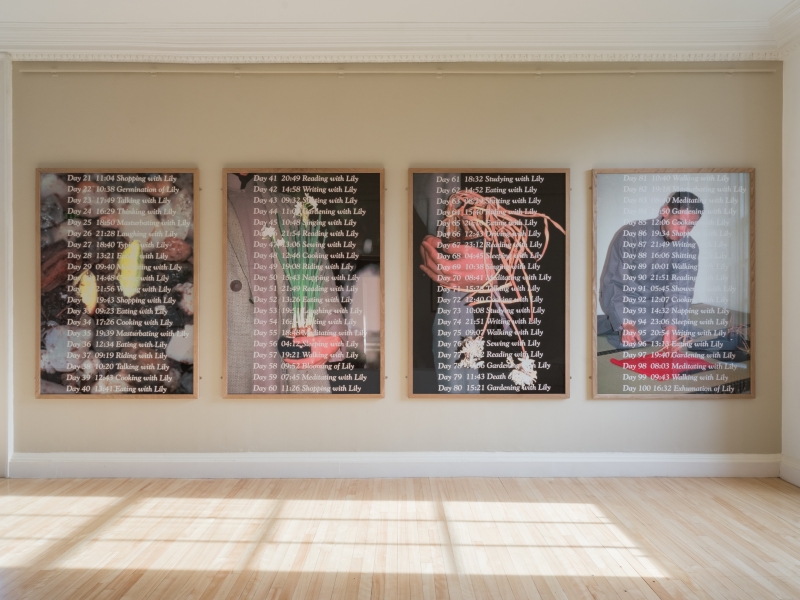Words for ‘Florilegium: A gathering of flowers’
Florilegium: A gathering of Flowers
16 October – 13 December 2020
Inverleith House
RGBE
Inverleith Row, Edinburgh EH3 5LR
Florilegium: A gathering of Flowers presents a comparison between contemporary and traditional artists uses of the botanical form. At work are complex shifts between the cultural, scientific, political, personal and historical bound into current narratives of the pandemic and observations on social isolation, migration, boundaries and borders. Scientific botanical drawings and watercolour illustrations are presented in a room of uninhibited overabundance speaking here of the disciplines of classification and nomenclature, sample, study, origins and archive, but which also point to colonialism and its artifacts, inside/outside, natural/unnatural, frontiers, wilderness and rationality. I think too these isolated botanical forms such as Rattikorn Bunprasit’s work Psilotum Nudum, 2020, the study of a simple and rare grass, begin to take on a metaphor for isolated human experience during this pandemic, as well other narratives of this moment that have required of us to reconnect with nature and what we understand as natural and valuable. This speaks of a time, indivisibly, entwining, human crisis and climate emergency.
This strategy for bringing together traditional methodologies with contemporary art reminded me of British artist Michael Landy’s pencil drawings of weeds, entitled Nourishment, 2002-2003 that he produced as a curative reaction to his performance installation Break Down, 2001 that saw the artist systematically destroy all of his belongings. Here then crisis is conflated with cure and in his (extreme) methodologies Landy reminds us that the weight of our possessions represent loss not abundance and is a disconnect, a distraction from nature.
Photographer Wendy McMurdo shows a suite of digitally fractured broken flowers described as Indeterminate Objects, 2019 which sees technology and biology meld into hybrid scattered forms – flora rendered as data and pixels merge violently, and sculpturally, with glass and liquid. This explosive collision brought to mind the installation Cold Dark Matter, 1991 by British artist Cordelia Parker. It attests to the instability, the sudden impermanence of things. Themes which continue into a second suite of photographic prints Night Garden, 2020 which considers, in the contexts of the lockdown, pandemic and the experience of personal loss, the garden as a site for growth and death, renewal and restoration. I am reminded of the installation Botanical Garden by German artist Isa Genzken presented at Inverleith House in 2014 as well as the film The Garden, 1990 by Derek Jarman, elegies which describe conflicts between lived experience, including distress, illness and grief, and retreats into spaces of natural beauty.
Artist and filmmaker Lyndsay Mann’s extraordinary feature length essay film, A Desire for Organic Order, 2016, presents an overlapping of moving image genres of documentary, diary entry, observational camera, artists’ experimental film, slow cinema and scientific research field recording to trace out complex ideas of migration, nativeness, belonging, conservation, dispersal, mind-flight and the intimate communications – desires – entrusted to letter writing mapped over images of and rituals surrounding the Collection at the Botanic Gardens itself. Working at the pace of the librarian and reminiscent of the 16mm film University Library, 2004 by filmmaker Rosalind Nashashibi, plural encounters, entwining the past, paranormal and present, offer multiple positions and temporalities voicing the complexities, ordered and disordered, of human and nonhuman experience.
Barbadian artist Annalee Davis’s suite of drawings As if the Entanglement of our Lives did not Matter, 2019-2020, illustrate an entwining of family portraiture with botanical studies on ledger papers of Bread and Cheese, Common Sow Thistle, Lady Palm, Paw-Paw, Sugar Cane, and Wonder-of-the-World making indirect comment on colonialism and the plantation system as sites of trauma, displacement and dislocation. Taiwanese-American artist Lee Mingwei’s quartet of photographic performance documents from 1995 read like an isolation diary, and give an intimate claustrophobic bodily account of cultivating and raising a single lily, over its natural life cycle, from seed to death, as curative action following the passing of the artist’s grandmother – the flower is offered as a surrogate, and his quotidian observations reveal a symbiosis of human and nonhuman care.
Signaling the exhibition’s sustained thematic of the thresholds between inside and outside Lee Mingwei’s new performance Invitation for Dawn, 2020 and Mann’s A Desire for Organic Order extend the gallery’s reach into the outside world using the Internet in particular as a means to distribute elements of its programme and connect with audiences in generous, measured and intimate ways.
